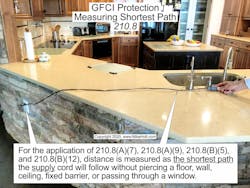Stumped by the Code? Requirements for GFCI Protection of Branch Circuit Receptacles in Dwelling Units
All questions and answers are based on the 2020 NEC.
Underlined text indicates revisions made in the 2020 Edition of the NEC.
Q. What are the NEC requirements for GFCI protection of branch circuit receptacles in dwelling units?
A. Ground-fault circuit interruption protection, located in a readily accessible location, must be provided in accordance with Sec. 210.8(A) through (F).
According to Art. 100, “readily accessible” means capable of being reached quickly without having to climb over or remove obstacles, or resort to the use of portable ladders. Article 100 also notes that a “ground-fault circuit interrupter” (GFCI) is a device intended to protect people by de-energizing a circuit when a current imbalance has a value of 6mA or higher and does not trip when the current to ground is less than 4mA.
A GFCI circuit breaker provides ground-fault protection starting at the breaker, so the entire circuit has ground-fault protection. A GFCI receptacle provides ground-fault protection for whatever is plugged into it and has load-side terminals that provide downstream protection for any other receptacle(s) or device(s) on the circuit.
For the application of Secs. 210.8(A)(7), 210.8(A)(9), 210.8(B)(5), and 210.8(B)(12), the distance is measured as the shortest path an appliance’s supply cord will follow without piercing a floor, wall, ceiling, fixed barrier, or passing through a window (Fig. 1). This new language literally serves to require a receptacle in an adjacent room and to have GFCI protection where that receptacle is within 6 ft of a sink. This would be the case in a house with a master suite and a bedroom receptacle outside of the bathroom doorway, but within 6 ft of the sink in the master bath.
(A) Dwelling Units. 125V through 250V receptacles installed in the following dwelling unit locations must be GFCI protected.
Note that this expansion applies no matter the ampere rating of the receptacle. It is no longer limited to only 15A and 20A receptacles as it was in the previous edition of the Code.
(1) Bathroom Area. GFCI protection is required for all receptacles located in dwelling unit bathroom areas.
According to Art. 100, a “Bathroom Area” is an area that includes a basin as well as one or more of the following: a toilet, urinal, tub, shower, bidet, or similar plumbing fixture.
(2) Garages and Accessory Buildings. GFCI protection is required for all receptacles located in garages of dwelling units and grade-level portions of accessory buildings used for storage or work areas of a dwelling unit.
(3) Outdoors. GFCI protection is required for all receptacles located outdoors of dwelling units, including receptacles under the eaves of roofs. Exception: GFCI protection is not required for a receptacle dedicated to fixed electric snow‑melting, de-icing, or pipeline and vessel heating equipment if the receptacle is not readily accessible and the equipment has internal ground-fault protection of equipment (GFPE) [Sec. 426.28 and Sec. 427.22].
(4) Crawl Spaces. GFCI protection is required for all receptacles located in dwelling unit crawl spaces at or below grade.
(5) Basements. GFCI protection is required for all receptacles located in finished and unfinished areas of a dwelling unit basement. Exception: A receptacle supplying only a permanently installed fire alarm or burglar alarm system is not required to have GFCI protection.
(6) Kitchen Countertop. GFCI protection is required for all receptacles that serve kitchen countertop surfaces.
Receptacles located below a countertop for appliances, such as trash compactors or garbage disposals, do not require GFCI protection unless they are located 6 ft or less from the top inside edge of the bowl of the sink [Sec. 210.8(A)(7)].
A refrigerator is not a countertop appliance; thus, GFCI protection is not required unless the receptacle is located 6 ft or less from the top inside edge of the bowl of the kitchen sink [Sec. 210.8(A)(7)] (Fig. 2).
Outlets supplying dishwashers require GFCI protection [Sec. 210.8(D) and Sec. 422.5(A)(7)].
(7) Sinks. GFCI protection is required for all receptacles located within 6 ft from the top inside edge of the bowl of a dwelling unit sink.
(8) Boathouses. GFCI protection is required for all receptacles located in a dwelling unit boathouse.
The Code does not require a receptacle to be installed in a boathouse, but, if any are installed, they must be GFCI protected.
(9) Bathtubs or Shower Stalls. GFCI protection is required for receptacles located within 6 ft of the outside edge of a bathtub or shower stall not installed within a bathroom as defined in Art. 100.
(10) Laundry Areas. GFCI protection is required for all receptacles installed in the laundry area of a dwelling unit.
(11) Damp and Wet Locations Indoors. GFCI protection is required for all receptacles installed in indoor damp and wet locations.






